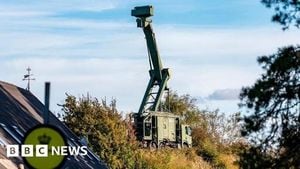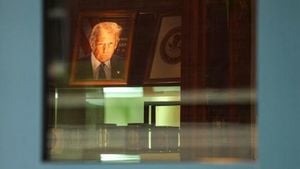Deep in Iran’s Zagros Mountains, a flurry of construction has reignited international concern over the country’s nuclear ambitions. Satellite imagery reviewed by multiple outlets—including The Washington Post and Iran News Update—shows that, far from halting its controversial nuclear program, Tehran is accelerating work on a fortified underground facility just south of the Natanz nuclear complex. The site, known variously as Pickaxe Mountain, Kuh-e Kolang, or Kirk Mountain, has become a focal point for analysts and policymakers alike, especially after devastating U.S. and Israeli airstrikes in June 2025 targeted Iran’s above-ground nuclear infrastructure.
The scale and secrecy of the construction are striking. According to The Washington Post, the facility sits about a mile (or 1.5 kilometers) south of Natanz and has been under excavation since 2020. The tunnels—estimated to plunge between 80 and 100 meters (roughly 260 to 330 feet) below ground—are potentially deeper than Iran’s already well-protected Fordow enrichment site. The compound itself spans roughly a square mile, with tunnel entrances on both the east and west sides. Heavy trucks, dump trucks, trailers, and other machinery have been spotted in satellite images, indicating a surge in activity since the June airstrikes.
Iran initially described the site as a replacement centrifuge assembly plant, meant to stand in for the one destroyed in a 2020 sabotage incident. But the sheer depth and breadth of the underground halls have led independent analysts to suspect a more clandestine purpose. As Joseph Rodgers, a fellow at the Center for Strategic and International Studies, put it to The Washington Post, “The presence of dump trucks, trailers, and other heavy equipment … indicates continued construction and expansion of the underground facility.”
Three key signs point to intensified work since the June 2025 attacks. First, the security perimeter has been dramatically reinforced—satellite images reveal that between 1,200 and 4,000 meters (up to 13,000 feet) of protective wall have been erected around the compound. Second, the tunnel entrances themselves have been fortified with rock and soil, presumably to withstand further airstrikes. Third, the volume of excavated rock and debris has sharply increased, evidence of continued tunneling and expansion. A new road has also been laid along the perimeter, further suggesting the site’s growing strategic importance.
The June 2025 airstrikes, carried out by U.S. B-2 bombers, Tomahawk missiles, and Israeli forces, were devastating by any measure. Analysts and officials report that nearly 22,000 centrifuges at Fordow, Natanz, and Isfahan were destroyed or disabled. For the first time in over a decade, Iran’s path to weapons-grade uranium appeared to be cut off—at least above ground. Yet, as The Washington Post notes, U.S. intelligence has issued more cautious assessments, acknowledging that the full extent of the damage at Natanz and Isfahan remains unclear. This uncertainty has fueled speculation that Tehran is now moving its most sensitive nuclear operations deeper underground, out of reach of conventional bunker-busting bombs.
Adding to the mystery is the fate of Iran’s stockpile of highly enriched uranium. Before the June strikes, the International Atomic Energy Agency (IAEA) reported that Iran had amassed nearly 400 kilograms (about 900 pounds) of uranium enriched to 60 percent purity—dangerously close to the 90 percent threshold needed for a nuclear weapon. The current location of this material is unknown. IAEA Director General Rafael Mariano Grossi has suggested that some of it may be buried underground, while CIA Director John Ratcliffe noted that much is likely trapped under the rubble at Isfahan and Fordow. Regardless, the ambiguity has stoked fears that Tehran could secretly use any remaining stockpiles for weaponization.
Official responses from Tehran have been, at best, evasive. The IAEA has never been granted access to the Pickaxe Mountain site, despite repeated requests. Grossi told PBS News Hour that Iran dismissed the agency’s questions about the facility. On September 9, 2025, Tehran and the IAEA announced an agreement allowing inspections of all nuclear sites, but Iran has since sent mixed signals about its willingness to comply. Ali Larijani, Secretary of Iran’s Supreme National Security Council, offered a characteristically ambiguous response in an interview with PBS’s Frontline: “No, nothing. We haven’t abandoned any of those locations. But in the future they could possibly continue to run as they currently do or be shut down.”
The stakes are high, and the decision-making power ultimately rests with Supreme Leader Ayatollah Ali Khamenei. President Masoud Pezeshkian has called for diplomacy, warning that efforts to rebuild nuclear sites could provoke further U.S. strikes. Yet, as Kelsey Davenport of the Arms Control Association cautioned, “Iran still has the capacity to reconstitute fairly quickly if they make the decision to.” Sara Burkhard of the Institute for Science and International Security emphasized the significance of the continued tunneling: “The fact they’re continuing to build this is significant.”
International reactions have been swift and wary. The White House has reiterated its longstanding position, with a senior official stating, “The administration will continue to monitor any attempt by Iran to rebuild its nuclear program. As President Trump has said, he will never allow Iran to obtain a nuclear weapon.” Meanwhile, the Associated Press reports that Iran is also rebuilding missile sites struck during the recent conflict with Israel, suggesting a broader pattern of military fortification and strategic depth.
Further complicating the picture is Iran’s deepening relationship with Russia. In a recent meeting in Moscow, Rosatom CEO Alexey Likhachev and Iranian Vice President Mohammad Eslami signed a memorandum of understanding for the construction of small nuclear power plants in Iran. While ostensibly civilian in nature, such cooperation could have implications for Iran’s nuclear infrastructure and technological know-how.
For now, the world is left to scrutinize satellite images and parse official statements for clues about Tehran’s true intentions. Experts warn that if Iran prioritizes stealth over speed, it could pursue a more secretive underground path to nuclear weapons capability—one that would be much harder for international monitors to detect or disrupt. “They seem to be playing it cool,” Jeffrey Lewis of the James Martin Center for Nonproliferation Studies observed, reflecting a cautious but determined Iranian strategy in the face of mounting pressure.
As September draws to a close, the fortified tunnels of Pickaxe Mountain stand as a symbol of Iran’s resolve—and the world’s enduring uncertainty. While exposed facilities may have been destroyed, Tehran’s nuclear ambitions, it seems, are now buried deeper than ever beneath the mountains of Natanz.




